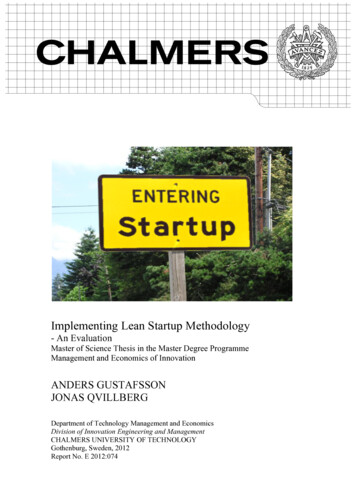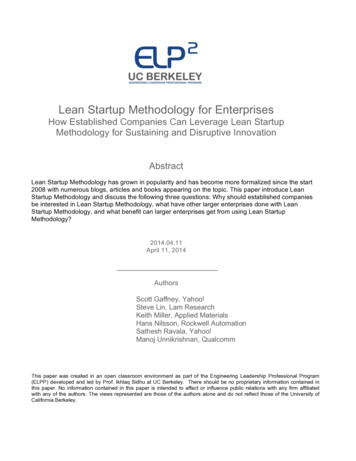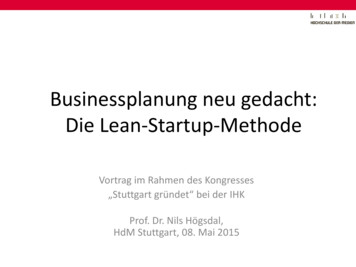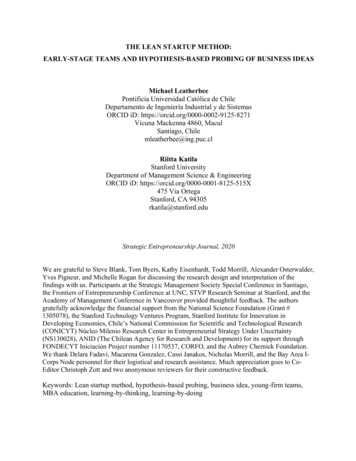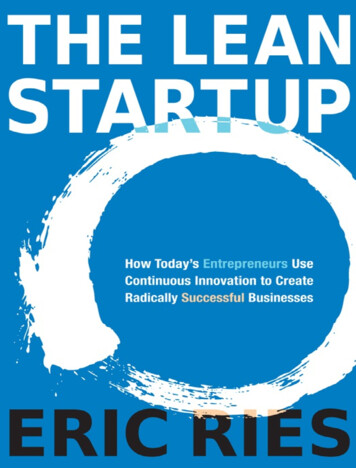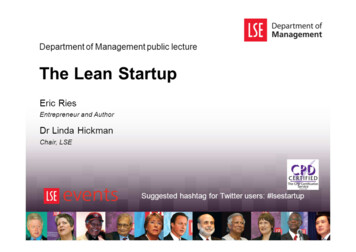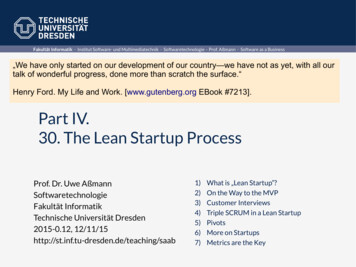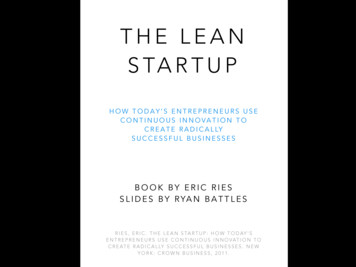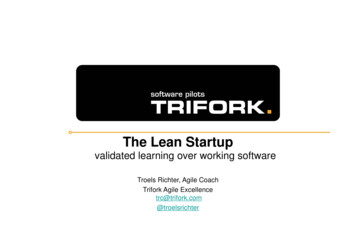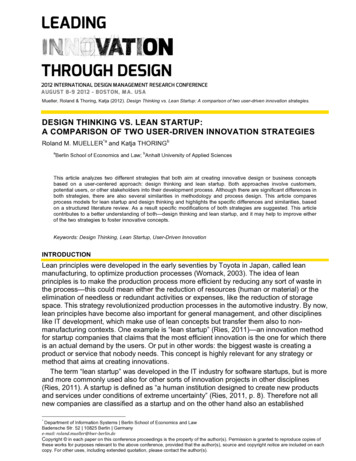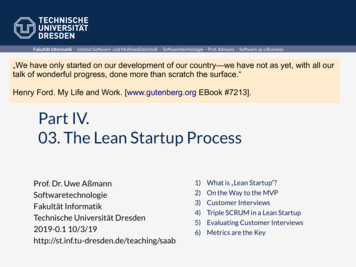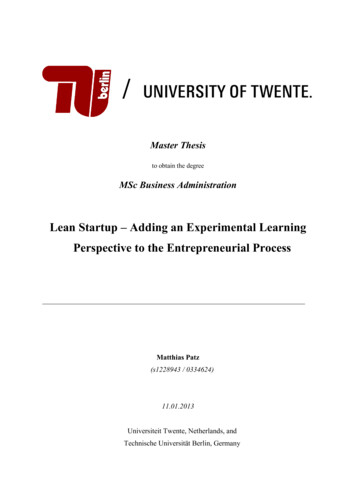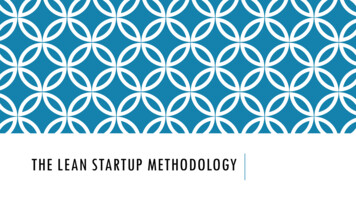
Transcription
THE LEAN STARTUP METHODOLOGY
IMPORTANT AUTHORS AND ENTREPRENEURS?Eric Ries?Edition 2011, Eric RiesThe New York Times Bestseller"Mandatory reading for entrepreneurs"Dan HeathSteve Blank
WHAT IS A STARTUP?“A startup is a human institution designed to deliver a newproduct or service under conditions of extreme uncertainty”Eric Ries
WHAT IS A STARTUP?Let’s dispel some Myths1.You don't have to work in a garage to be in a startup2.Startups are not smaller versions of large companies3.Not any small business is a startup4.Startups also deals with bureaucratic commitmentsLet’s outline the main characteristics1.Startup deals with uncertainty, contrary to most businesses (large and small alike)2.Failure needs to be seen as a useful tool for learning3.A startup is greater than the sum of its parts; it is an acutely human enterprise.4.A startup is an organization formed to search for a replicable and scalable business model.
SUCCESSFUL STARTUPSDROPBOXAIRBNBUBER Founded: 2007 by Drew Houston, ArashFerdowsi Lean Startup Methodology principles: 3 minutevideo which demoed their product’s first build,explained their core value proposition anddemonstrated how easy it was for people toshare files across their devices. Results: in 15 months, it went from 100,000registered users to over 4,000,000. Founded: 2007 by Brian Chesky, Joe Gebbia Lean Startup Methodology principles: theapproach has been to focus on reinforcing thecore experience following constant userfeedback rather than adding unnecessaryfeatures Results: Airbnb is now worth an estimated 30billion and is used in 191 countries around theworld. Founded: 2010 by Garett Camp, Travis Kalanick Lean Startup Methodology principles: Uber wasa simplified mobile interface only used by thefounders and their friends. To gain access you hadto email one of the founders. Features that wenow use were slowly introduced. Results: Uber is valued at an estimated 68billion and is active in 77 countries.
WHY STARTUP FAILS More than 90 % of startup fails Underlying problem: startup founders and investors are notaware of the context in which they operate, they continue toemulate large companies and think that they will achievesuccess. Main belief: all we need to do is draw up a Business Planwith the utmost accuracy, and then just execute it. For 40 years we have been convinced that executing thisplan worked to achieve success “No Business Plan survives first contact with customers". SteveBlank https://www.youtube.com/watch?v eUoae9lHpYThis happens . when traditional methods, suitablefor stable environment and existingcompanies are applied.
BUSINESS PLAN VS BUSINESS MODEL CANVASThis does not mean that we mustnever formulate an operationalplan, but only that before doingso we need a certainfact/evidence "Get out ofthe building".A suitable tool for organizingthese facts is the proposedBusiness Model Canvas byAlexander Osterwalder. It is adynamic, flexible model that isupdated day by day. In thiscase the business model is builtprogressively and evolves alongwith the company business.
BUSINESS MODEL CANVAS1.Key partners: network of suppliers and partners that make the business model work. (business, manufacturers.)2.Key activities: strategic activities a company must do to make its business model work. (R&D, control of production andmanufacturing, manage website and online order, Marketing and promotion of the product )3.Key resources: internal resources allowing the development of key activities and the creation of the value proposition.(physical, human, intellectual)4.Customer relationship: types of relationships a company establishes with specific Customer Segments. (co-creation, personalassistance, community)5.Customer segments: practice of dividing a customer base into groups of individuals that are similar in specific ways, such asage, gender, interests and spending habits to identify one or more Customers segments whose value proposition is delivered.6.Channels: tools used to reach its customer segments and deliver the value proposition. (PoS, online sale/distribution)7.Value proposition: bundle of products and services that created value for a specific customer segment.8.Cost structure: all costs incurred to operate a business model.9.Revenue streams: represents the cash a company generates from each Customer Segment
WHAT STARTUPS NEEDStartupA flexible legislationsystemA new approach to doManagementEnvironment thatencourages theirdevelopment
THE LEAN STARTUP METHODOLOGY: A NEW METHOD TO DOMANAGEMENTCore concepts of the LEAN STARTUP vs Core Concepts of theTRADITIONAL MANAGEMENT approachEXPERIMENTATIONCUSTOMER FEEDBACKITERATIONVSRoots Lean Manufacturing (Toyota)Taiichi Ohno e ShigeoShingo. Philosophy: "GenchiGenbutsu" meaning "Go andSee for yourself to thoroughlyunderstand the situation”. Design thinking Customer and Agiledevelopment - Steve BlankELABORATE PLANNINGINTUITIONBDUF
THE METHODOLOGY IN DEEPLean Startup challenges the traditional management practices of today’s biggest companies. Themethodology entails the following 3 main phases: vision, steer and accelerate.1. VISION2. STEER3. ACCELERATE
THE METHODOLOGY IN DEEP: VISIONValidated Learning: implies the launch of empirical experiments/teston 2 testable hypotheses about your business, to see if customers arewilling to adopt the new product.Potential of Early adopters: Value Hypothesis: verifies if a product or service brings value to thecustomer. (is the product valuable to customers?)Minimum Viable Product (MVP): Growth Hypothesis: evaluates how the product spreads from theearly adopters (the first users of the product) to the mass market.(how to obtain and retain customers?)Thanks to the experiments, the launch of firstproducts (MVP) enable to gather accurate dataon the target (much more valid than a marketresearch). Market Niche The 80% prefer a solution, not a perfectproduct. What matters to them is to be first to adoptthe new product/service. Their feedback are crucial, they fill in anyproduct gap
THE METHODOLOGY IN DEEP: STEER1. To be a "startupper" you have to create an idea, a product, which is anexperiment, then improve it based on feedback and continue until you getto the product that customers want. This procedure consists of following theBuild-Measure-Learn (BML) feedback loop, core of the Lean StartupmethodIdeas2. Once empirically validated the hypothesis (value and growth), the idea isto create a MVP that lacks many functionalities in order to complete theBML and scientifically test the hypothesis with minimum effort and time.3. Once the product is launched, its impact must be measured. We useinnovation accounting: it objectively demonstrates if you are creating asustainable business. This system transforms the 2 hypotheses into aquantitative financial model.4. It evaluates if it is time to pivot or make a structural course correction totest a new fundamental hypothesis (product, strategy and engine ofgrowth).DataProduct
THE METHODOLOGY IN DEEP: ACCELERATEStartups must take into account several decisions and analyse their different nuances. For example, they must evaluate when to launch a product; They must quantify how many resources to invest; And finally, they must also maintain an organization that allows employees to remainencouraged and continue to do validated learning.Lean Startup also wants to convey techniques that allow startup to be agile:1.Small batches: allow to discover upstream any "bug" in the production process, enablingthe correction of errors before resources/time/money are spent (eg Toyota). By reducingthe batch size the BML cycle loop is completed more quickly.2.Other take inspiration from JIT and WIP techniques. The aim is to reduce stock as theyrepresent a costs and turn processes from push to pull.
IT'S YOUR TURN: CREATE YOUR OWN STARTUP!In group, fill in the Business Model Canvas.Observe, Reflect, Make and . try to come up with aninnovative and human-centred idea!TIPSYou can take inspiration from the following themes:- Environment & Sustainability- Welfare- Digital transformation
Lean Startup also wants to convey techniques that allow startup to be agile: 1. Small batches: allow to discover upstream any "bug" in the production process, enabling the correction of errors before resources/time/money are spent (eg Toyota). By reducing the batch
